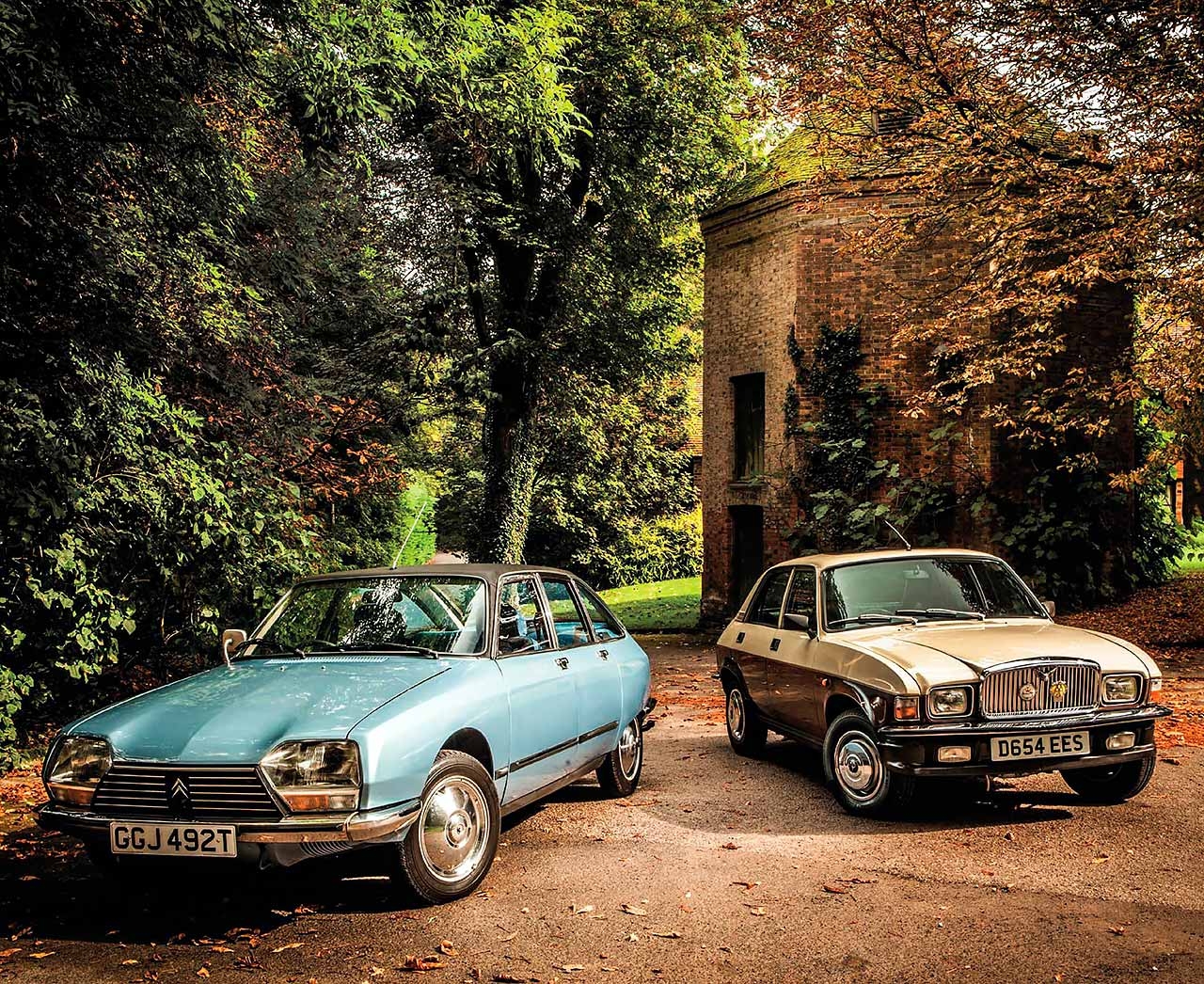
Style for the masses Citroën vs Vanden Plas. Small town luxury. Vanden Plas 1.7 versus Citroën GS Pallas. Avant-garde for the masses. Andrew Roberts samples two innovative, well-equipped saloons – the Citroën GS Pallas and Vanden Plas 1.7 – that can now be yours for a bargain price. Photography Tony Baker.
At first sight, the Citroën GS Pallas and the Vanden Plas 1.7 seem about as incongruous as that 1977 Bing Crosby duet with David Bowie, yet their parallels are quite marked. Each is a socially aspirational front-drive saloon that made its debut in the 1970s and, when the Austin Allegro was launched in ’1973, one of its major rivals was the GS. So it seemed only logical to compare the two, very different, flagship versions of each in the gracious surroundings of Lainston House Hotel near Winchester.
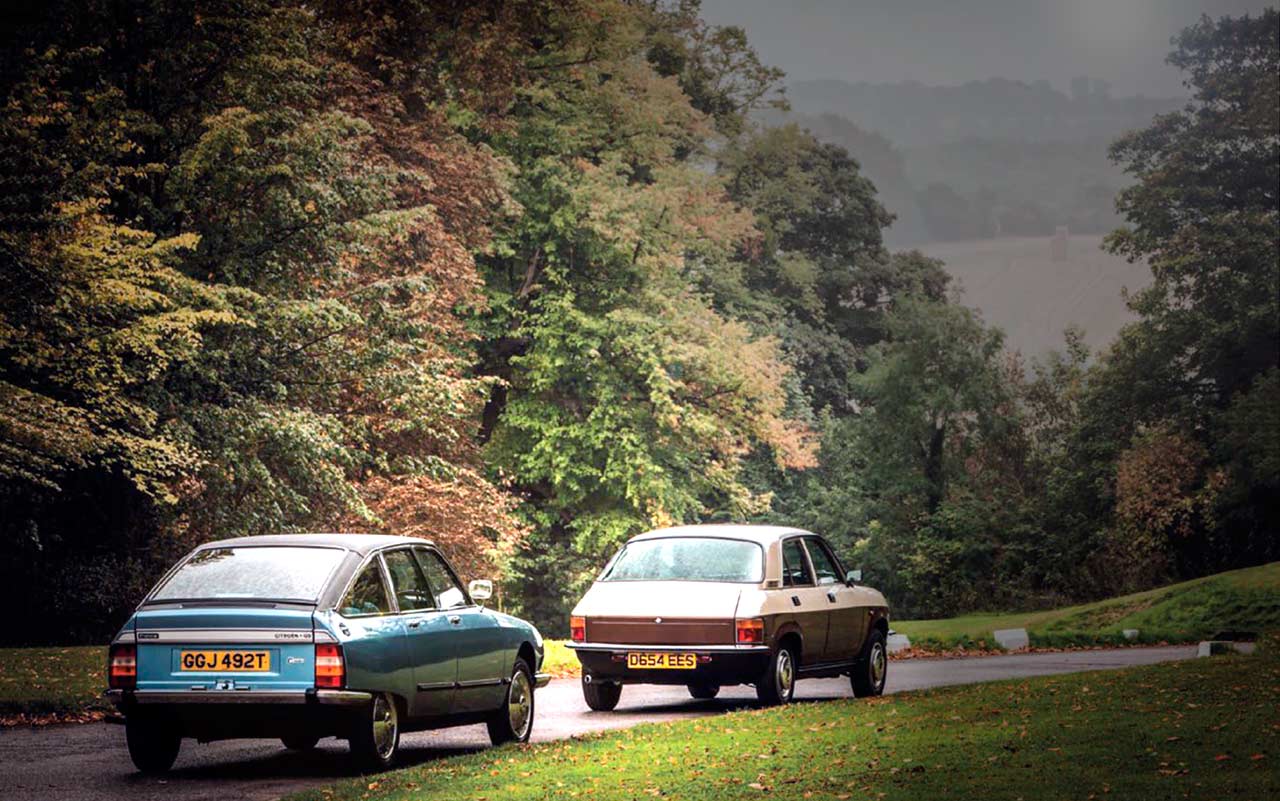
The GS was introduced in October 1970 as Citroën’s long-awaited medium-sized model to bridge the gap between the Ami 8 and the entrylevel D Spécial (or ID, as was). Back then, a mass-produced front-drive saloon with hydropneumatic suspension, a ride adjustable to three heights, plus inboard disc brakes fore and aft would have seemed revolutionary – even without Robert Opron’s attractive styling. The Kamm tail and aerodynamic lines anticipated the CX, and one of the few indications of the design’s age was the slot for a starting handle.
The Citroën GS was named Car of The Year ahead of the SM in third place and the surprising choice of the Volkswagen K70 in second. British- market sales commenced in ’1971, and a 1222cc engine option to augment the 1015cc air-cooled flat-four was added during the following year. By the middle of the decade, the GS Club was a fairly common sight in the UK, but the Pallas, which was introduced in 1975, always seemed to be a car above lesser vehicles.
That impression is reinforced by Graham and Linda Wilson’s 1978 example because the GS Pallas conveys an air of quiet distinction, from its metallic paint finish and tinted glass to the downright svelte hubcaps and Jersey nylon upholstery. Here was ‘luxury in a new dimension’ and even the standard vinyl roof enhances the Pallas’ image, rather than giving it the character of a medallioned Hai Karate wearer en route to the Berni Inn near Portsmouth.
In France, the Citroën’s principal competitors, the Peugeot 304, Renault 12TS and Simca 1100 Spécial were all front-wheel-drive designs, but in the UK its only equivalent contemporary was an exclusive version of the Allegro – the Vanden Plas 1500. The Kingsbury-based coachbuilder had been owned by Austin since 1946, and had the status of a separate marque since 1960. Eight years later, the demise of the Princess 4 Litre R and the launch of the Vanden Plas-bodied Daimler DS420 marked a change in the company’s image, and its future seemed to lie in conversions of Jaguar products rather than producing cars under its own brand.
The Vanden Plas interpretation of the ADO16 1100/1300 remained a strong seller, however, yet plans for its Allegro-based successor were in place from as early as 1971. On 17 September 1974, the press gathered at Kingsbury for the launch of the Vanden Plas 1500; it was never badged as an Allegro. The seats were upholstered in the finest Connolly leather, the dashboard was finished with walnut veneer and Wilton carpets adorned the floor. There was also a distinct lack of the notorious quartic steering wheel, and the frontal treatment incorporated foglamps plus the trademark grille. ‘Luxurious yet unostentatious, powerful yet economical, the Vanden Plas 1500 is truly a car for the discriminating motorist,’ claimed BL, with a becoming lack of modesty.
The Vanden Plas treatment was completed in two days, with Allegros being driven from the West Midlands to London. The 1500 cost over £2000, making it almost twice the price of a basic Allegro, but it did appeal to its intended customer base. One motoring journalist of the 1970s thought that the VdP was ‘very much aimed at folk who have retired from senior jobs’, and detail improvements such as rear picnic tables made it even more appealing to motorists who felt that society was going to the dogs.
The Vanden Plas received the improved Hydragas suspension of the ’1975 Allegro Series 2, although when the third-generation Austinbadged models gained ‘stylish’ (ghastly) plastic trim detailing in 1979, the VdP fortunately escaped such excesses. Vanden Plas had initially opted to use the 1.5-litre Maxi-type E-series engine because the average VdP customer was not known for his or her interest in being first away from the traffic lights, but by the end of the decade there was the option of a single-carburettor 1748cc unit in addition to improved front seats. The renamed Vanden Plas 1.5 and 1.7 were to be short-lived because the Kingsbury works closed in November 1979, and the run-out models were built in Abingdon until the demise of that plant in October of the following year.
Our featured car is one of the last of the breed – indeed, it remained unsold until 1986 – and the most polite phrase to describe its appearance is ‘refreshingly different’. There has been more than enough print devoted to the story of the Austin Allegro over the past two decades, of how Harris Mann’s thoughtful concept was compromised by senior management and how, in hindsight, the quartic wheel was probably a bad idea. Likewise, the Vanden Plas model has frequently been singled out for abuse over the years. In 1989, the late, great Russell Bulgin wrote, with tongue mildly in cheek, that it was a ‘seminal British design, combining classic elegance with the timeless appeal only a real commitment to quality can engender’.
The passage of time, however, has lent the last of the Vanden Plas cars considerable charm and fascination. Replacing the Princess 1100/1300 was always going to be a challenge for BL and, with the Allegro-based models, the balance between contemporary and ‘traditional’ is arguably less happy. Kingsbury’s treatment of the exterior is low key, providing a welcome contrast to the flamboyance of the 1750 Equipe, and the duotone paint on this 1.7 has echoes of the Great Western Railway’s colour scheme. But there is no avoiding the fact that the square grille really does not work when combined with an Allegro nose, for the overall effect is akin to Margaret Rutherford guest-starring in The Sweeney.
The cabin was one of the major sales features of both cars and, naturally, the interior of the Pallas has zero resemblance to a gentleman’s study circa 1934. The UK market was denied the ‘cyclops’ speedo, but the cabin still has the air of the departure lounge in 2001: A Space Odyssey.
You sink into a driver’s seat that is so comfortable you temporarily forget the woes of the day and gaze at a fascia decorated with instruments, warning lamps and switches, some of which look to have been applied at random. Those idiosyncrasies are inevitable with a Citroën, plus the handbrake sprouting from the centre of the dash (following a last-minute change to a floor shift) and the optional radio slotted between the front seats are integral aspects of the GS experience.
In contrast, the interior of the Vanden Plas gives a fascinating insight into the class system of the 1970s and early ’80s. No other saloon of the same size – or most bigger ones – could boast seats trimmed in Connolly hide or a brushednylon headlining. The Ford Escort Ghia Mk2, its nearest rival in terms of décor, seemed less Mayfair club and more ambitious sales director’s living room. BL reckoned that the 1500 was ‘Totally international in concept, equally at home in Rome or Paris or Vienna – yet its distinctive air of good breeding is unmistakably British’. In fact, the VdP seemed rather less suited to the Kärntner Straße than it was in the driveway of a neo-Georgian villa somewhere in Weybridge.
The more expensive Austin models were already well-equipped cars, but the Kingsburytrimmed version offered the buyer a sense of genuine quality. At a time when British Leyland’s products were regularly being berated in the press, and when management commissioned The Quality Connection – a factory training film concerning ill-built Allegros running over famous character actors – the Vanden Plas provided an oasis of taste and craftsmanship. One strong reason for the VdP’s six-year production run is that Kingsbury’s standards were almost certainly far higher than those of Longbridge.
Perhaps the key difference between the Citroën and the Vanden Plas is that the former encourages the driver to delight in its technical wizardry, as opposed to revelling in pomp and circumstance. The Pallas was only available with the 1.2-litre engine and, even though it is considerably smaller than the VdP’s unit, there is never a sense of strain – just the opposite, in fact. The powered brakes are so sensitive that they will bring the GS to a halt with a gentle touch on the pedal – anything heavier is ill-advised – and the Wilsons’ car is fitted with the optional C-Matic semi-auto gearbox. The ratios of the three-speed transmission are well chosen, allowing the novice Pallas driver to take corners with verve and marvel at, in the words of the late LJK Setright: ‘The best steering geometry ever built into a production car.’ Then there is the suspension that maintains a constant ride height; once the Pallas has gathered speed, it really does appear to glide, unperturbed, over poorly surfaced roads.
Meanwhile, any VdP owner could boast of a suspension set-up consisting of interconnected displacers that were partially filled with nitrogen. Anyone who drove a luxury car that rode on cushions of gas was clearly far more attuned to the modern world than the VdP’s image would imply. The Allegro pioneered the ambitious Hydragas set-up but the early cars suffered from poor damping, which bounced the occupants around in the cabin. BL made efforts to refine the system and, while the 1.7 does not feel quite as smooth as the Citroën, it displays little of the pitching that was a criticism of the early Austins.
A five-speed transmission was another unusual fitting for a British car of this era, although many customers would have specified an automatic gearbox, while the seats look exceptionally lavish and feel most comfortable. The E-series engine note dispels any faint illusions that you are piloting a scaled-down Silver Shadow, but the Vanden Plas standards of craftsmanship applied as much to the Allegro-based car as as they did to a Daimler Double-Six.
Of course, a company less embroiled in a seemingly never-ending series of crises than BL might have offered the Vanden Plas with power assistance to combat the heavy steering, which is especially noticeable at low speeds and probably limited its appeal as chic urban transport.
The GS was facelifted into the hatchback GSA in 1979 and production continued for a further seven years. Rust has largely consumed the surviving models, but the Vanden Plas 1.7 is almost as rare – and both now have an equal if individual fascination. The Citroën is much more than the ideal model for anyone aspiring to greater comfort and performance than an Ami.
It is arguably one of the finest mass-produced vehicles of its day, one that applied groundbreaking engineering to a family saloon. In the late 1970s, there were some parts of the UK that regarded colour television with suspicion so imagine the Wicker Man-like consequences of a Pallas suddenly arriving in a remote village.
If the Citroën GS eagerly anticipated the future, the VdP deliberately harked back to an almost-mythical past. The 1.7 was the last car to bear the Vanden Plas marque badge because the subsequent Metro, Maestro and Montego used the name as a trim level and, wisely, dispensed with any attempt at an elaborate radiator grille.
Many critics overlook the fact that the Allegro concept was one of considerable promise and, had BL properly realised its potential, the Vanden Plas might well have enjoyed wider appeal. As it is, the self-conscious gentility of the car with ‘that look of distinction’ remains perfect for any motorist who thought that afternoon tea was the highlight of the day.
Thanks to Linda and Graham Wilson, Citroën Car Club (www.citroencarclub.org.uk); Allan Rudge, The Vanden Plas Owners’ Club (www.vpoc.info); everyone at Lainstone House (www.exclusive.co.uk/lainston-house)
‘THE GS ENCOURAGES YOU TO DELIGHT IN ITS WIZARDRY WHILE THE VdP WANTS YOU TO REVEL IN ITS POMP AND CIRCUMSTANCE’
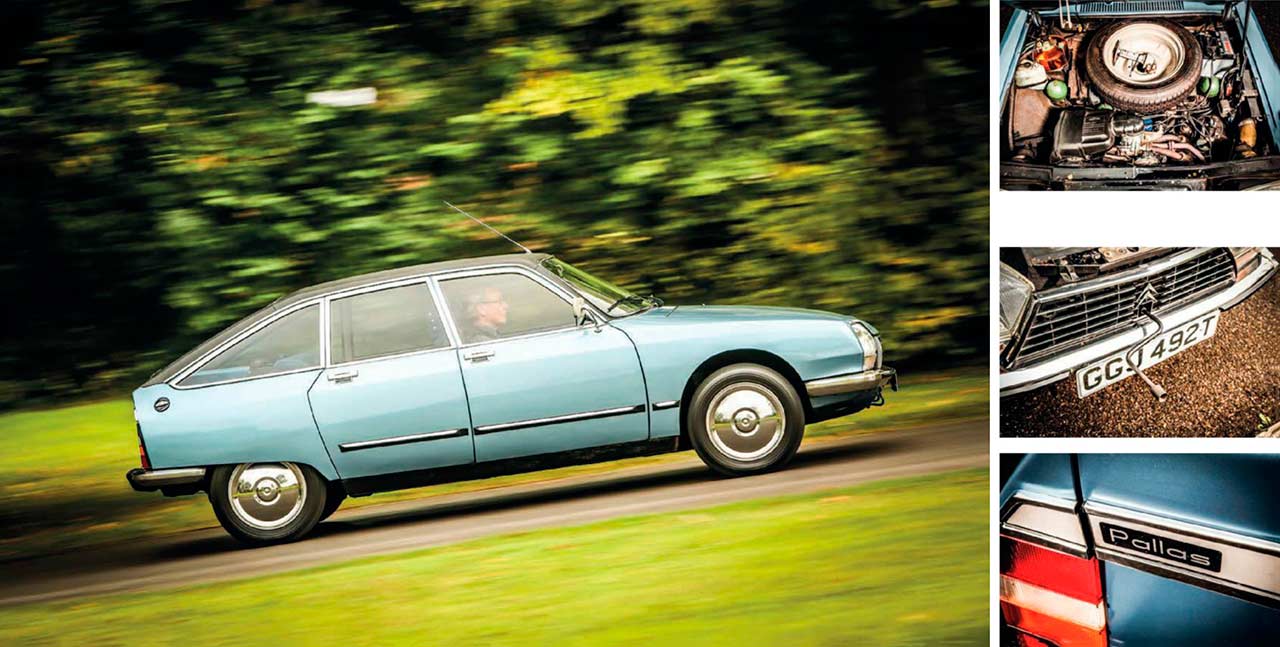
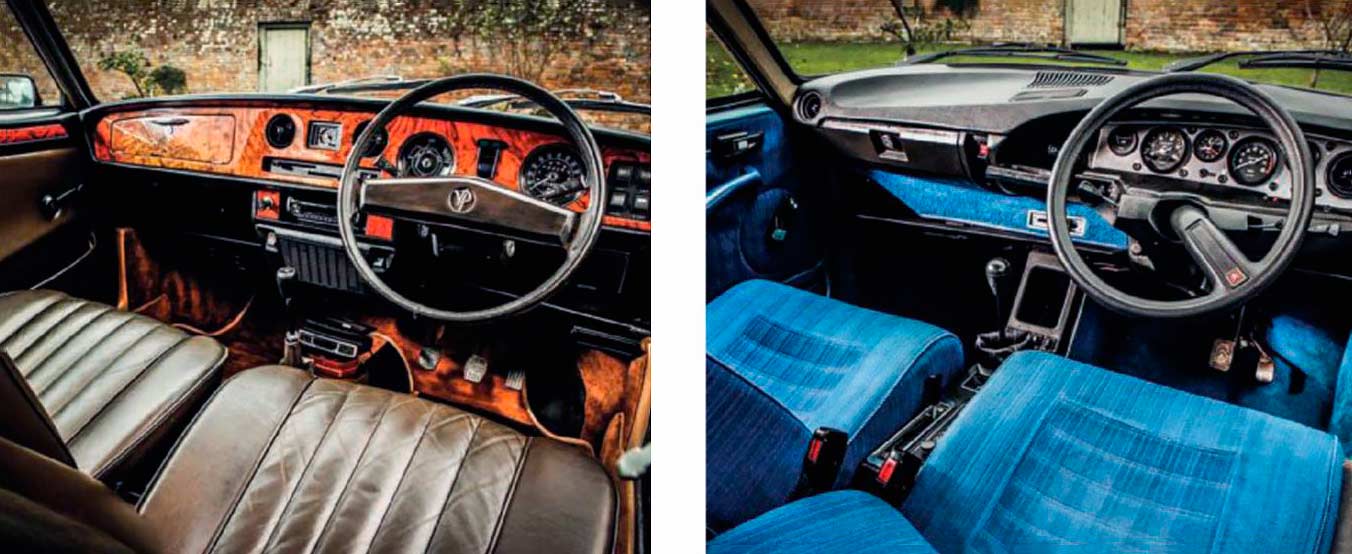
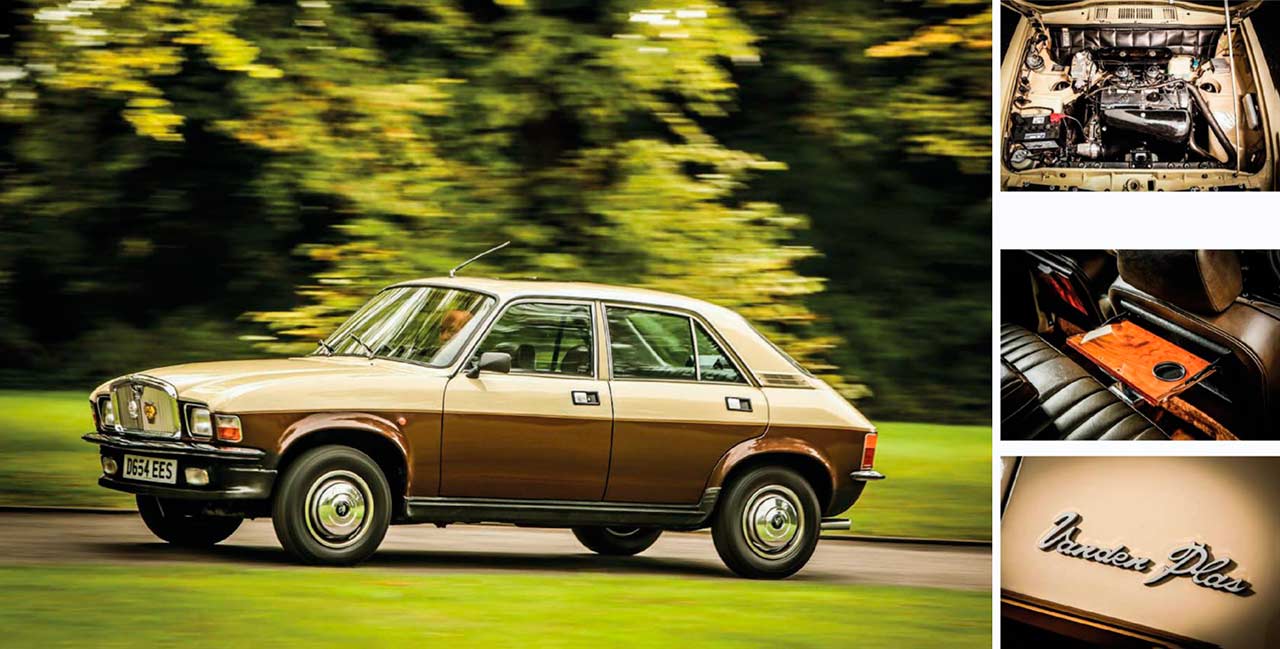
TECHNICAL DATA FILE SPECIFICATIONS CITROËN GS PALLAS
Sold/number built 1970-’1979/1,874,754 (all)
Construction steel monocoque Engine all-alloy, sohc-per-bank 1222cc flat-four, twin-choke Weber carburettor;
Power and torque 60bhp @ 6500rpm; 64lb ft @ 3250rpm (DIN)
Transmission four-speed manual or optional three-speed C-Matic semi-auto, FWD
Suspension independent all round, at front by double wishbones rear trailing arms; interconnected hydropneumatic spheres f/r
Steering rack and pinion
Brakes powered discs
Length 13ft 6in (4115mm)
Width 5ft 3 ½ in (1613mm)
Height 4ft 6in (1372mm)
Wheelbase 8ft 4 ½ in (2553mm)
Weight 1927lb (874kg)
0-60mph 14.8 secs
Top speed 95mph
Price new £1953.90 (’1975 UK)
Now £3500-5000 (2017 UK)
TECHNICAL DATA FILE SPECIFICATIONS VANDEN PLAS 1.7
Sold/number built 1974-’1980/11,842
Construction steel monocoque
Engine all-iron, sohc 1748cc ‘four’, SU carb;
Power and torque 76bhp @ 5000rpm; 97lb ft @ 2300rpm (DIN)
Transmission five-speed manual or optional three-speed auto, driving front wheels
Suspension independent all round, at front by double wishbones rear trailing arms; interconnected Hydragas displacers f/r
Steering rack and pinion
Brakes discs front, drums rear, with servo
Length 12ft 8in (3861mm)
Width 5ft 3 ½ in (1613 mm)
Height 4ft 7 ½ in (1410mm)
Wheelbase 8ft (2438mm)
Weight 2000lb (907kg)
0-60mph 12 secs
Top speed 96mph
Price new £1950 (’1974 UK)
Now £3-5000+ (2017 UK)





